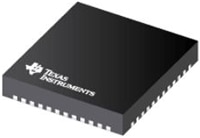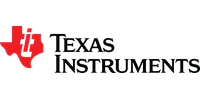 Texas Instruments' CC2652RB SimpleLink multiprotocol 2.4 GHz wireless crystal-less MCU with integrated TI bulk acoustic wave (BAW) resonator technology supporting Thread, Zigbee®, Bluetooth® 5.1 low energy, IEEE 802.15.4, IPv6-enabled smart objects (6LoWPAN), proprietary systems including the TI 15.4-Stack (2.4 GHz), and concurrent multiprotocol operation through the dynamic multiprotocol manager (DMM) software driver. Integrated BAW resonator technology eliminates the need for external crystals without compromising latency or frequency stability. The CC2652RB device is optimized for low-power wireless communication and advanced sensing in building security systems, HVAC systems, medical, power tools, wired networking, portable electronics, home theater and entertainment, and connected peripheral markets.
Texas Instruments' CC2652RB SimpleLink multiprotocol 2.4 GHz wireless crystal-less MCU with integrated TI bulk acoustic wave (BAW) resonator technology supporting Thread, Zigbee®, Bluetooth® 5.1 low energy, IEEE 802.15.4, IPv6-enabled smart objects (6LoWPAN), proprietary systems including the TI 15.4-Stack (2.4 GHz), and concurrent multiprotocol operation through the dynamic multiprotocol manager (DMM) software driver. Integrated BAW resonator technology eliminates the need for external crystals without compromising latency or frequency stability. The CC2652RB device is optimized for low-power wireless communication and advanced sensing in building security systems, HVAC systems, medical, power tools, wired networking, portable electronics, home theater and entertainment, and connected peripheral markets.
Features
- Powerful 48 MHz Arm® Cortex®-M4F processor
- EEMBC CoreMark® score: 148
- In-system programmable Flash: 352 KB
- ROM for protocols and library functions: 256 KB
- Cache SRAM: 8 KB
- Ultra-low leakage SRAM: 80 KB
- 2-pin cJTAG and JTAG debugging
- Supports over-the-air upgrade (OTA)
- Ultra-low-power sensor controller with 4 KB of SRAM
- TI-RTOS, drivers, bootloader, Bluetooth 5 low energy controller, and IEEE 802.15.4 MAC in ROM
- RoHS-compliant package: 7 mm x 7 mm RGZ VQFN48 (31 GPIOs)
- Digital peripherals can be routed to the GPIOs
- External: integrated bulk acoustic wave (BAW) resonator, on-chip buck DC/DC converter
- Wide supply voltage range: 1.8 V to 3.8 V
- Sensor controller, low-power-mode, 2 MHz, running infinite loop (30.8 µA)
- Sensor controller, active-mode, 24 MHz, running infinite loop (808 µA)
- Standby: 0.94 µA (RTC on, 80 KB RAM, and CPU retention)
- Radio section:
- RF transceiver: 2.4 GHz
- Excellent receiver sensitivity
- Programmable output power up to +5 dBm
- Suitable for systems that comply with worldwide radio frequency regulations
Applications
- ISM/SRD systems (2,400 MHz to 2,480 MHz) with down to 4 kHz of receive bandwidth
- Building automation: fire safety systems, video surveillance, and elevators/escalators
- Grid infrastructure: smart meters, grid communications, and other alternative energy
- Industrial transport, asset tracking
- Factory automation and control
- Medical
- Electronic point-of-sale (EPOS), electronic shelf labels (ESL)
- Personal electronics: gaming and wearables (non-medical)
 Texas Instruments' CC2652RB SimpleLink multiprotocol 2.4 GHz wireless crystal-less MCU with integrated TI bulk acoustic wave (BAW) resonator technology supporting Thread, Zigbee®, Bluetooth® 5.1 low energy, IEEE 802.15.4, IPv6-enabled smart objects (6LoWPAN), proprietary systems including the TI 15.4-Stack (2.4 GHz), and concurrent multiprotocol operation through the dynamic multiprotocol manager (DMM) software driver. Integrated BAW resonator technology eliminates the need for external crystals without compromising latency or frequency stability. The CC2652RB device is optimized for low-power wireless communication and advanced sensing in building security systems, HVAC systems, medical, power tools, wired networking, portable electronics, home theater and entertainment, and connected peripheral markets.
Texas Instruments' CC2652RB SimpleLink multiprotocol 2.4 GHz wireless crystal-less MCU with integrated TI bulk acoustic wave (BAW) resonator technology supporting Thread, Zigbee®, Bluetooth® 5.1 low energy, IEEE 802.15.4, IPv6-enabled smart objects (6LoWPAN), proprietary systems including the TI 15.4-Stack (2.4 GHz), and concurrent multiprotocol operation through the dynamic multiprotocol manager (DMM) software driver. Integrated BAW resonator technology eliminates the need for external crystals without compromising latency or frequency stability. The CC2652RB device is optimized for low-power wireless communication and advanced sensing in building security systems, HVAC systems, medical, power tools, wired networking, portable electronics, home theater and entertainment, and connected peripheral markets.













